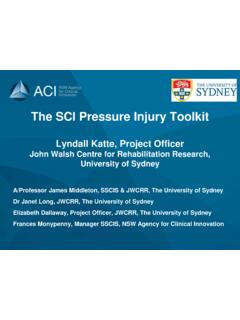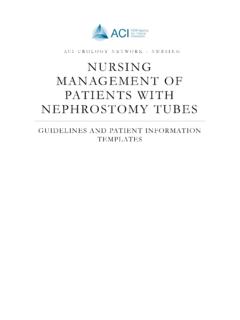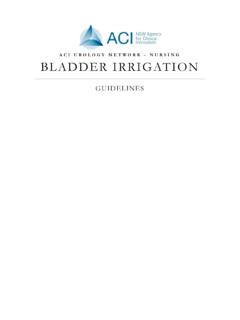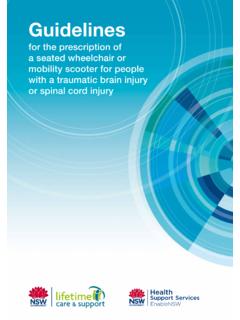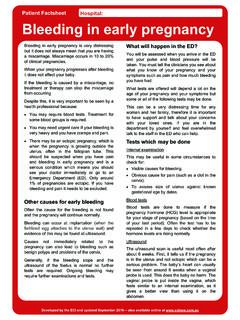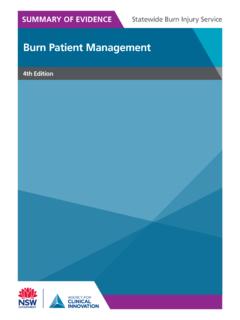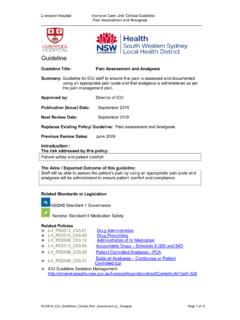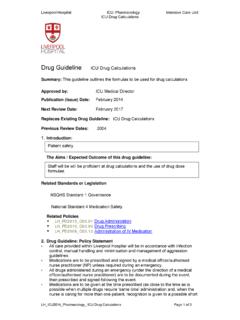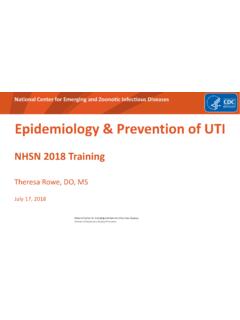Transcription of Bladder Irrigation: Management of Haematuria
1 Bladder Irrigation: Management of HaematuriaGUIDEACI Urology Network The Agency for Clinical Innovation (ACI) works with clinicians, consumers and managers to design and promote better healthcare for NSW. It does this by: service redesign and evaluation applying redesign methodology to assist healthcare providers and consumers to review and improve the quality, effectiveness and efficiency of services specialist advice on healthcare innovation advising on the development, evaluation and adoption of healthcare innovations from optimal use through to disinvestment initiatives including guidelines and models of care developing a range of evidence based healthcare improvement initiatives to benefit the NSW health system implementation support working with ACI Networks, consumers and healthcare providers to assist delivery of healthcare innovations into practice across metropolitan and rural NSW knowledge sharing partnering with healthcare providers to support collaboration, learning capability and knowledge sharing on healthcare innovation and improvement continuous capability building working with healthcare providers to build capability in redesign.
2 Project Management and change Management through the Centre for Healthcare Clinical Networks, Taskforces and Institutes provide a unique forum for people to collaborate across clinical specialties and regional and service boundaries to develop successful healthcare innovations. A priority for the ACI is identifying unwarranted variation in clinical practice and working in partnership with healthcare providers to develop mechanisms to improve clinical practice and patient for Clinical Innovation67 Albert Avenue Chatswood NSW 2067PO Box 699 Chatswood NSW 2057 T +61 2 9464 4666 | F +61 2 9464 4728 E aci | (ACI) 190155; ISBN 978 1 76081 100 6 Produced by: ACI Urology NetworkFurther copies of this publication can be obtained from the Agency for Clinical Innovation website at : Content within this publication was accurate at the time of publication. This work is copyright. It may be reproduced in whole or part for study or training purposes subject to the inclusion of an acknowledgment of the source.
3 It may not be reproduced for commercial usage or sale. Reproduction for purposes other than those indicated above, requires written permission from the Agency for Clinical Innovation. Version: 2 Date amended: June 2019 Trim: ACI/D19/1957 ACI_0195 [06/19] Agency for Clinical Innovation 2019 Working with Aboriginal People The ACI is committed to improving the health of all patients across NSW, particularly those who have significantly higher rates of health problems and less access to appropriate health services. Many sufferers of prostate cancer and its related complications fit into this category including those of the male Aboriginal available data indicates that prostate cancer is one the most prevalent cancers to affect the Indigenous male population, with very similar mortality rates to the Non Indigenous population. However, there may be cultural sensitivities that make complications surrounding prostatectomy and other potential causes of Haematuria to less likely be recognised and discussed Aboriginal Health Impact Statement was undertaken prior to commencement of this project and consultation has occurred with senior Aboriginal health workers, focus groups and representative organisations.
4 We would like to thank the key stakeholders whose contributions have informed the recommendations arising from this project. These stakeholders, including those who work closely with Aboriginal people, will continue to be involved in the implementation of the recommendations. It is important that the appropriate steps are taken to ensure that services are delivered in culturally safe and competent ways across the project lifespan. To achieve optimal health outcomes for Aboriginal people with complications resulting in Haematuria , we will need to undertake a cultural audit to identify and address the barriers to access to care and ongoing Management . The audit, along with the development of culturally competent and safe services, is described in detail in Chronic care for Aboriginal people model of guide was originally written by Virginia Ip, Clinical Nurse Consultant (CNC) Urology, the Royal Prince Alfred Hospital for the Agency for Clinical Innovation (ACI) Urology you to the panel of clinical reviewers.
5 Suzanne Cruickshanks, CNC Continence, the Continence Service of the University Medical Clinics of Camden and Campbelltown Hospitals Colleen McDonald, CNC Urology, Westmead Hospital Karina So, CNC Urology, Concord Repatriation General Hospital Michelle Paul, Nurse Practitioner, Community Health, Greater Newcastle Cluster Wendy Watts, CNC Urology, John Hunter Associated urinary tract InfectionCBIC ontinuous Bladder IrrigationIUCI ndwelling urinary CatheterPersonal Protective Equipment (including PPEprotective eyewear, plastic apron/disposable gown and gloves)TURBTT rans Urethral Resection of Bladder TumourTURPT rans Urethral Resection of ProstateACI Urology Network Bladder Irrigation: Management of Haematuria iContentsWorking with Aboriginal People iAcknowledgements iGlossary iIntroduction 1 Health professionals 2 Roles and responsibilities 2 Competency 2 Compliance to relevant guidelines 3 Compliance 3 Continuous Bladder irrigation 4 Equipment 4 Procedure 5 Intermittent Bladder irrigation via a closed system 6 Equipment 6 Procedure 7 Manual Bladder irrigation for managing clot retention 8 Signs and symptoms of a blocked catheter 8 Equipment 8 Procedure 9 Required documentation 10 Clinical progress notes 10 Fluid balance chart 10 Patient Management 11If the amount of drainage is less than the irrigant infused 11If there is an increase in Haematuria or clots present 11If the patient is experiencing pain 11If there is leakage around the catheter (bypassing) 11If the patient becomes confused or agitated post TURP 11 Appendix 1: Clinical Skill Assessment Form: Continuous Bladder Irrigation for Clearing Clot Retention 12 Appendix 2: Clinical Skill Assessment Form.
6 Manual (Intermittent) Bladder Irrigation for Clearing Clot Retention 14 References 16 ACI Urology Network Bladder Irrigation: Management of Haematuria IntroductionThis guide has information about Bladder irrigation, which can be used to prevent blood clot formation, allow free flow of urine and maintain urinary catheter patency. It has information for health professionals performing Bladder irrigation, including their roles and responsibilities, compliance to relevant guidelines and required are three methods of Bladder Irrigation: 1. continuous Bladder irrigation (CBI)2. intermittent Bladder irrigation via irrigation pump bag3. manual Bladder is information about patient Management issues, including how to deal with pain, irritation and Skill Assessment Forms can be used to gauge compliance see Appendices 1 Urology Network Bladder Irrigation: Management of Haematuria 1 Health professionalsThe following health professionals can perform Bladder irrigation: medical officers registered nurses (RNs) accredited endorsed enrolled nurses undergraduate student nurses under the supervision of a RN urologists or urology and responsibilitiesMedical officer Documents the order and clinical indication of Bladder irrigation in the clinical progress notes Reviews the Bladder irrigation at least dailyRegistered nurse Maintains the patient s comfort Ensures urinary catheter patency and urine drains freely Monitors the degree of Haematuria and the presence of clots, and adjusts the irrigation fluid infusion rate accordingly Ensures an adequate supply of infusing fluids is nearby and stored at room temperature to avoid Bladder spasm Responsible for documentation (accurate record of urine output, urine colour/degree of Haematuria , presence of clots if any and if manual Bladder irrigation was required) Provides catheter care, securing the indwelling urinary catheter (IUC)
7 Appropriately to minimise movementCompetencyPrior to performing insertion of urinary catheter and/or Bladder irrigation, the health professional should be able to demonstrate prior knowledge, understand the risks and to the standard set by the LHD or healthcare Urology Network Bladder Irrigation: Management of Haematuria 2 Compliance to relevant guidelinesThe health professional should follow local Local Health District or healthcare provider guidelines on urinary catheterisation and Bladder irrigation ( Adult Urethral Catheterisation for Acute Care Settings1).The following other guidelines should also be followed: Catheter associated urinary tract infection ( cauti ) Aseptic technique is required for performing Bladder irrigation, catheter care and maintenance to reduce the risk of a cauti ) secondary to contamination during the procedure and break in the closed urinary drainage system. Refer to the Clinical Excellence Commission Hand hygiene A policy outlines the specific hand hygiene practices required to minimise the risk of Infection control A policy outlines the broad principles of infection Medication handling The best practice principles on medication procurement, storage, prescribing, supplying, dispensing and administration at NSW public health to these guidelines will achieve the expected outcomes: maintained urinary catheter patency maintained patient s comfort prevention/minimisation of clot formation cauti risk Urology Network Bladder Irrigation: Management of Haematuria 3 Continuous Bladder irrigationContinuous Bladder irrigation (CBI) is used to reduce the risk of clot formation and maintain indwelling urinary catheter (IUC) patency by continuously irrigating the Bladder via a three way catheter.
8 The three way catheter allows fluid to flow into and out of the Bladder simultaneously. A large gauge IUC is used to allow for drainage of clots and debris. The use of sodium chloride (normal saline) is recommended. Use sterile equipment and aseptic three way normal tip catheter has three ports: a large internal lumen that is reinforced to avoid collapse when the pressure of manual irrigation is applied, large eyes which facilitate easier evacuation of clots, and a third port allowing for continuous three way Haematuria (whistle tip) catheter has the same features as above, except the tip is blunt and requires the use of an introducer for insertion. This catheter can therefore only be inserted by urologists or urology way Haematuria (whistle tip) catheterEquipment Alcohol based hand rub Personal protective equipment (PPE): protective eyewear, plastic apron and gloves Dressing trolley Dressing pack 2x Sodium chloride (normal saline) irrigation bags (volume as per facility procedure) 70% isopropyl alcohol wipes CBI set IV pole 6x 70% alcohol swabs Sterile gloves Waste bag Disposable underpadFigure 1.
9 Continuous Bladder irrigationBag in useSpare bag2 litre irrigation fluidNormal salineUrine drainage bagOutlet tube for emptying bag3 way foley catheterContinuous irrigationBalloon channelACI Urology Network Bladder Irrigation: Management of Haematuria 4 Procedure 1. Perform hand hygiene in accordance with the 5 moments in hand Verify patient s identity, confirm the procedure, obtain consent and check for allergies. As part of this process: Assess the patient s health literacy (understanding of the procedure). Ask patient if he or she identifies as Aboriginal or Torres Strait Islander. If so, provide access to Aboriginal Liaison Officer to provide support with health literacy. Provide an interpreter for patients who require Check if a three way Foley catheter is in situ. Note: A three way Foley catheter must be in situ, and if one is not in place, it must be inserted (refer to facility procedure for insertion of an indwelling urinary catheter). 4. Clean dressing trolley with 70% isopropyl alcohol wipes.
10 Allow drying, then gather equipment, and check the sterility and integrity of sterile items. Take to the Ensure patient Position patient in supine position, allowing for easy access to the IUC to minimise the need for staff to twist, bend or maintain awkward static postures. Obtain assistance if required. 7. Place a disposable sheet under the patient s Empty the urine drainage bag (refer to facility procedure). Record measurement on the fluid balance Perform hand Put on PPE (protective eyewear, plastic apron and non sterile gloves).11. Ensure the IV pole is at a safe accessible height before hanging the sodium chloride flasks. 12. Insert the prongs from the irrigation set into the flasks and prime irrigation tubing, expel air and close the clamp. Do not remove the silicone protective tube from the connector at this time hang the tubing from the IV pole. Maintain asepsis. 13. Raise and secure the IV pole to the appropriate height. Note: When priming, open one irrigation flask only as the fluid can run from one flask to the other.
